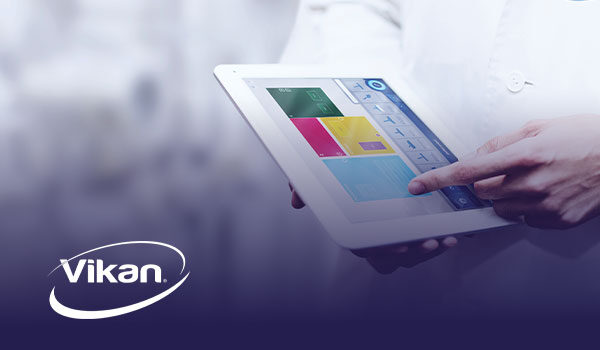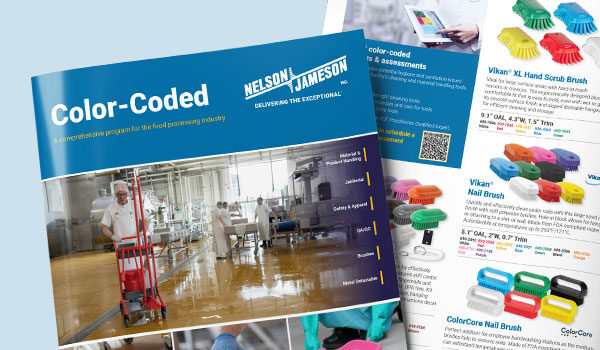
There are a few reasons to add a new color to an existing color-coding plan. From changes in products to changes in processes or regulations, sometimes keeping processes streamlined means adding a color to avoid confusion.
Generally, we tend to recommend that each employee should only need to touch tools in 1-3 colors throughout their day to prevent confusion. Smaller plants can use color-coding plans that make use of four or five colors to create zones based on process steps or ingredients. Larger plants that have many different processing lines running at the same time may need more colors to keep their shifts, zones, process steps, and allergens separated. Regardless of size, a facility may decide to add a new color to its color-coding plan to divide out a processing step or denote tools used with a new allergen.
Here are the three steps to take when adding a new color to a color-coding program:
There are two main reasons to add a new color to a plan that already works well: changes in process or changes in products. However, there are also specific instances where adding a new color could increase food safety and worker efficiency.
A new color could be helpful if you're:
Be aware that simple is often better when it comes to color-coding. Adding a new color isn’t always the best solution. For instance, if you notice workers mixing up tools, it may be the case that more education, training, and signage are needed instead of another color.
Just like the tools themselves, color should be fit for purpose. For example, dark colors like gray or brown work well outdoors and on floors because they’ll typically get dirty fast and stay that way throughout their lifespan. Because the colors can hide dirt well, they’re also an excellent choice for high-visibility areas like hallways and lobbies. Light colors are an excellent choice for finished products because it’s easier to visually identify if the tool has a crack that could harbor bacteria or if it simply needs to be cleaned or replaced. Lime and other vivid colors work well for allergens since the bright hue is easily seen, even by color-blind employees.
Colors should be easy to spot against the product they’ll be used with. Choosing yellow for wheat may make sense when it comes to remembering the color-coding scheme, but the matching hues won’t be helpful if a scraper gets dropped into a vat.

When adding colors, all planned changes should happen at one time. This helps to minimize confusion and create a smooth transition. The day before the colors are to be added, signs should be posted and managers should remind employees about the upcoming changes.
Before the change goes into effect, training on how the change will benefit the plant and help keep the food supply safe should help get everyone on the same page. This can also increase food safety culture by giving employees a chance to become invested in the updated color-coding program. Training programs that strike a balance between being short and informative are more likely to positively influence employees.
Manager oversight is essential, especially during the first few days or weeks after the change, depending on the plant’s culture. If mistakes are made once the new colors are added, have additional training sessions and make sure there’s adequate signage in every language spoken in the facility.
Though color-coding plans are often best kept simple, sometimes that simplicity requires adding another color. This change can be spurred by process or ingredient changes or by new regulations. Regardless, adding new colors to a color-coding program should be accompanied by training, signage, manager oversight, and more training as needed to ensure the program’s success.
Information provided by Vikan®

Vikan is a leading supplier of hygienic cleaning tools and insight for the food & beverage industry and other hygiene-sensitive environments in North America.

November 13, 2025
In the demanding field of occupational safety, protecting workers requires more than just offering equip...

November 12, 2025
For professionals who must maintain productivity and a secure grip in frigid conditions, the MCR Safety ...
.jpg)
November 12, 2025
In demanding, hygiene-sensitive environments like food manufacturing and dairy processing, effective pro...

Recognize and address possible hygiene and sanitation challenges based on the cleaning and material handling equipment available in your facility.
Through a discovery call, virtual, or on-site assessment, Vikan SQF Practitioner certified specialists will assist in confirming that your system and cleaning tool inventory aligns with your risk management objectives while pinpointing any missing tools and enhancing maintenance and usage practices. Evaluate whether your existing tools are utilized in the most effective manner, or determine if a more suitable tool exists for the task at hand. Ensure that your tools comply with all relevant standards and regulatory requirements. Site evaluations encompass a summary survey, an overview of the location, a color-coded factory layout plan, product suggestions, a recommended order form, and a proposal for a follow-up survey.
Food Safety, Sanitation, Cleaning Tools, Color Coding

This is a comprehensive program for the food processing industry. Nelson-Jameson brings together the most extensive collection of color-coded products for material handling, product handling, janitorial, safety, apparel, QA/QC, and metal-detectable applications. With the right pieces, a color-coding system is a powerful tool in preventing cross-contamination of allergens and food-borne illnesses that can lead to sickness or expensive product recalls.

Food Safety, Sanitation, Cleaning Tools, Color Coding

With existing and emerging threats, food safety has never been more important to food manufacturers in protecting their consumers and their organization.
Color Coding

Laboratory, Color Coding, Food Safety